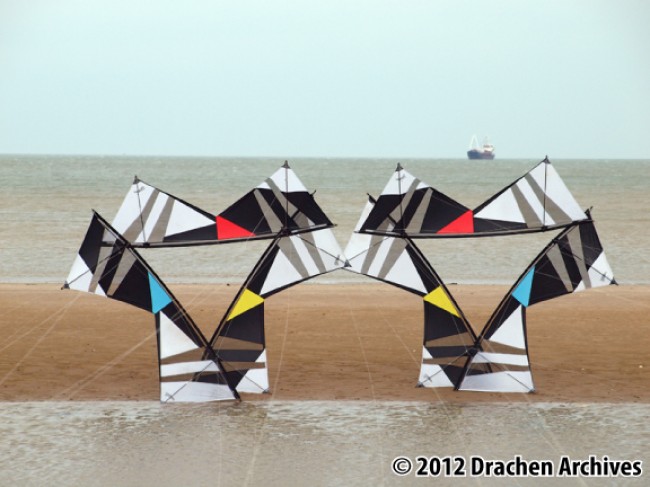Perhaps it is a bit “odd” to have so many individuals write about one kitemaker. But that is the point, he is one SPECIAL kitemaker, and I am sure there are hundreds more who would and are waiting to step up to their computers to write something about this phenomenal man, Jørgen Møller Hansen.
What follows are three tributes to Jorgen and I encourage you to read them all. RIP (rest in peace) our friendly Fanø Dane.
Ali Fujino Executive Director Drachen Foundation
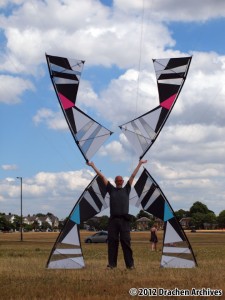
His kites you may well know; the apparently simple, almost minimalist graphics based on white, black or grey with the inclusion of a single colour, the pattern chopped and rearranged to create balance and tension. Some designs could be gently decorative, like the patterns in drapery painted by Matisse; others could be bold and almost aggressive, the diagonal lines slashing boldly from left to right, cut and rearranged like collage in a Russian constructivist composition. They were undoubtedly some of the most ambitious attempts at a pure, fine-art approach to kite design; the kite was Jørgen’s canvas, the sky his gallery wall.
Jørgen lived in Aarhus, a port town on Denmark’s east coast, famous for its sail-making industry and deeply affected by its relationship with the sea. When reminded of his Viking ancestors, he’d usually respond with a cry of ‘Rape and Plunder!,’ typical of his robust sense of humour.
Jørgen’s kites had the same attention to manufacturing excellence as the sails he saw in the sail lofts. Close up you’d see the reinforcements and strengthening strips; the kites were made to last and could seem almost heavy on the ground, but up in the air they seemed fragile and delicate and flew superbly, a combination of great craftsmanship and sharp design.
The Decorators met Jørgen for the first time in Berlin in 1989, before the Berlin wall came down; he had arrived by train in West Berlin, his kites somehow ending up in the east. He was standing in the middle of the kite field holding the end of a hairy bit of string, to which was tied a very makeshift kite made of gardening canes and a plastic bag, a murderous look on his face. We gathered up the courage to talk to him and spent the next two days rocking with laughter. When asked that first evening where he came from, he decided to draw a map of most of northern Europe on the paper table cloth in the restaurant. Running out of space on the cloth before he’d even got to Hamburg, he dispossessed the neighbouring party of their table, added it to ours and kept drawing, finishing with a final flourish and declaring ‘and that’s where I live!.’
Over the last 23 years, Jørgen has designed the sails for our Revolution kites, making us instantly, uniquely recognisable. He loved the way the Revolution kites could come together in different combinations, constantly breaking and reforming his picture, emphasizing different aspects of his design, accentuating one element or another. In 1992, shortly after he met his future wife Karen, he travelled with us to the US on what we called the Rok and Rev tour. Jørgen designed and made a series of Rokkaku kites which we flew on multi-line bridals in combination with the Revolution kites to form a big, ever-changing scene; a kinetic sky-picture.
Working with Jørgen has deeply affected the way we approach flying Revolution kites as a team, taking a much more pictorial approach to our routines, rather than the linear, sequential-manoeuvre based flying that prevails in team display. We carry his vision of a huge, ever changing picture with us constantly. Along with his lovely wife Karen, his family, many friends and kite fliers, we shall miss him hugely.
Jacob Twyford Member, The Decorators
The worldwide kite community has lost an artistic giant; Denmark’s Jørgen Møller Hansen has passed away after battling cancer. Upon meeting Jørgen at the end of 2011, on our favorite Danish island, Fanø, I hoped that Jørgen had won his battle against the cancer, as he was animated, strong in his opinions, and full of Danish pride. He even asked that I keep him in mind as a presenter for upcoming kite retreats. He had prepared a wonderful presentation of graphic ideas appropriate for kite-makers. When he was unable to attend the 2012 Kitefliers’ Meeting at Fanø, in June, I knew that he must have been terribly sick – he had attended every one of the Meeting’s 28 years and was the lone Danish kiteflier for many of its early years.
I had the pleasure of knowing Jørgen for over thirty years and was always anxious to see what he might pull from his kite bag. Always it was something unique, striking, and completely identifiable as Jørgen’s. Along with his friend, and kite mentor, Peter Malinski, Jørgen attended the Junction Texas International Kite Retreat in one of its early years. His trip through the American Southwest remained one of his fondest memories and many of his friends, made at Junction, made the effort to travel to Denmark and experience the phenomenon that is Fanø. There is little doubt in my mind that in the early years of the Kitefliers’ Meeting, Jørgen felt the pressure of being the only Danish kiteflier and responded with the fantastic kites that were to become his artistic legacy.
Take a moment to just look at Jørgen’s work; I like the fact that he didn’t try to invent new kite forms, instead, he arranged them in multiples, added simple details, and always made them graphically unique. One of his earliest kites (which is shown in the slideshow) was the collapsible box-train, “Stairway to Heaven,” a kite that most would not attempt and few have made so beautiful. As you can see, he made a number of trains, but his were noteworthy because of the way he manipulated simple, basic kite forms and arranged them into visually appealing and aerodynamically surprising creations.
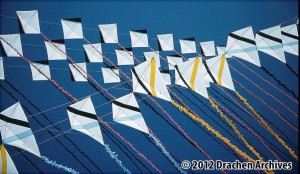
Another of Jørgen’s trademarks was his use of white as the background in the majority of his kites. This allowed him to take great advantage of contrast, as he usually used strong black geometric elements highlighted by minimal splashes of color. Every time I saw a new kite of Jørgen’s I knew he had followed a very important graphic principle: “take detail out.” He had a particularly keen sense of knowing what amount of graphic work could carry his message and he didn’t embellish to make sure the viewer saw what he saw. He adjusted this ethic to suit the type of kite that he was creating. His Revolution kites made for his friends in The Decorators, were understated masterpieces that complemented one another, but could stand alone in the sky, as well. The Decorators felt that Jørgen was a full-fledged member of their team because of the effect his kites had on their audiences. The simple but infinitely variable graphic design of today’s commercial Revs probably owes a nod of gratitude to Jørgen’s influence.
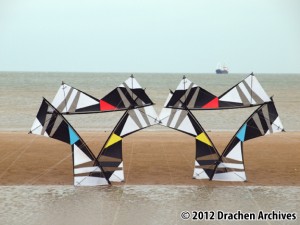
Jørgen loved the parafoil and had made several before visiting the United States. On that first trip to the US and in subsequent meetings at Fanø, Jørgen picked the brains of Ed and Bonnie Wright, parafoil-makers and, themselves, students of San Francisco’s George Ham. Improving upon his original technical designs, Jørgen’s later foils were fine flyers and even more graphically impressive.
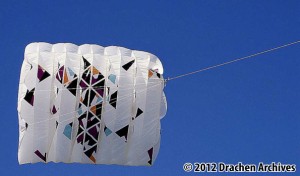
Finally, I must talk a little about the personal friendship with Jørgen that I valued so much. I traveled to Denmark for the first time in 1991 and stayed with German friends in one of the family campgrounds. In an ordinary year, you’d say that accommodations were pretty upscale; small cabins, showers no more than 100 feet away, outdoor cooking and eating areas. But this was a year that it rained from Monday through Thursday. The wet, howling wind made life a little less than enjoyable for much of the week. Enter Jørgen. He stole me away from my camping friends and drove me to the small village of Sønderho. This is one of Denmark’s most famous traditional villages and in it is a wonderful bed-and breakfast where I was treated to a real “Danish” pastry and a Kaffe-punch. Jørgen explained the formula for the Kaffe-punch; place a kroner in the cup, add coffee until you can’t see the coin, then add schnapps until you can see the coin again. Needless to say, I had to experience this small part of Danish culture. In subsequent visits to Fanø, Jorgen cooked traditional Danish dishes for me and other friends, talked about the history of the island, walked with us while we looked for amber, and, of course flew kites in his Danish wind. There is the potential for a world-class kite museum and wind-center to be built on the island of Fanø. Jorgen was in the original discussions for this center and if it comes to fruition, it would be a fitting tribute to the artist, the kiteflier, the man, the Dane, who was Jørgen Møller Hansen.
Scott Skinner Board President, Drachen Foundation July 2012
In June 1985, three dozen kitefliers met for first time at the Danish island of Fanø.
This is an island, where the wind blows strong across the beach, making visibility very difficult, and we thought we just couldn’t see the people who had come to the island to join us in flying kites. We found it wasn’t just the wind and sandstorm, but no one was really there.
Suddenly, a dark figure moved along the sand and came closer. We recognized the figure was a person on a bicycle with a large plastic tube on his back. The man stood before us with a bright smile on his face saying:
“Hello, I am Jørgen from Denmark, Aarhus, I want to fly my kites with you.”
We could hardly believe it! A Danish man on a bicycle who flies kites? He showed us his kites and we were even more surprised!
Thus began, a long friendship between Jørgen and the German kitefliers.
Born in 1954, Jørgen studied at the art craft school of Kolding (Denmark). Later, he worked as a graphic designer in Aarhus, Denmark. Early in his design career, he began to study the design of kites, and began to produce them in his own unique art style. This style was so remarkably good in design and production, he began to teach kite making at different art colleges in Sweden, Norway and Denmark.
His kites where made as a combination of aerodynamics, graphic skill and a “playful flying” manner. Most of his kites looked like a creation from a master virtuoso composer. His compositions were clear, clean and precise. Often he use white as a background color attached with shades of black. Then he added the colours red, yellow and blue. His bold, exciting graphic combinations were easy for the public to enjoy and this style of kite design brought him invitations from all over the world to fly his kites. Jørgen always said, “I prefer to make one unique, interesting kite instead of making ten of the same boring ones.”
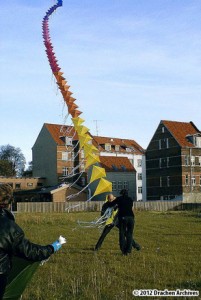
Jørgen was inspired by music when he designed his kite sails. So many of his kites looked like a paper of sheet music, but his sails where made of ripstop nylon. Through his gift of design, he could make the viewer think that the kite was of paper, even if it was in fact ripstop. He never forgot how his materials would react in various winds, and he skilfully could produce kites that would fly in any wind range.
An unforgettable kite is his nylon kite, “Stairway to Heaven.” A combination of 155 quadratic cells rigged like an accordion, it flew pointed straight into the sky, thus illustrating Jørgen’s true mastery of aerodynamic practices and design.
Jørgen’s kites inspired the kite world. His designed kite sails for other kitefliers, like the English Revolution quad kite team, The Decorators. Understanding the manner in which the kite flew, he designed perfect graphics for the kites to enhance the way the kites would be used in performance.
Kites world inspire Jørgen. For example, he loved the kites of German artist Peter Malinski. Artists kites where special to him, and Peter´s work motivated him to a higher creativity, showing homage and collaboration of styles in his own works.
Jørgen was a great human being. Sometimes not easy to convince about doing things a certain way, his personal conviction of his art brought forth personal power on every challenge he took. He would succeed at anything he did.
I never forget how he taught us a Danish lesson at Fanø, for the 10th Anniversary of the Kite Meeting. With a lot of humor and Danish charm, he taught thousands of kitefliers his language and so won their hearts. No undertaking was too difficult for him.
Around Denmark he organized a lot of kite festivals. His involvement never ended on the field of the festival. After kiteflying during the day, Jørgen would always invite us to his home and show us his hearty friendship and hospitality. His very good kite friends from Denmark, Norway, and all over the world could not resist flying kites with him. Since his first time at Fanø, he never missed a kitefliers meeting on the island.
When a small group of kite enthusiasts where brought together to explore the idea of making a world “Wind Center” on Fanø, Jørgen was the first one we asked to help us with the idea. He worked hard with the group to make this dream come true. I will never forget that night when we discussed and drew out ideas long into the night, and Jørgen stayed up later to put all our ideas together in a “perfect” presentation that gave a clear graphic view of our vision.
Jørgen died on the 7th of July. He leaves not only an empty space in the sky, but also in the hearts of his family and his friends.
Wolfgang Schimmelpfennig July, 2012
;

